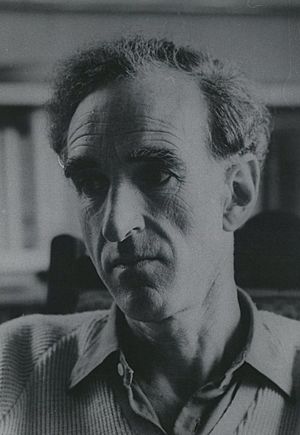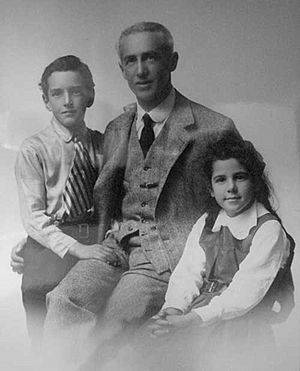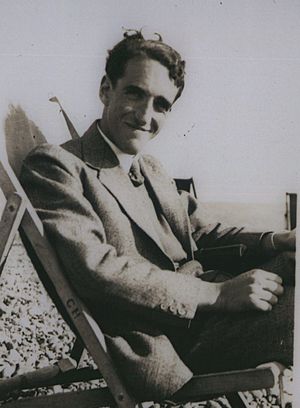Charles Brasch facts for kids
Quick facts for kids
Charles Brasch
|
|
|---|---|

Brasch, c. 1960
|
|
| Born | Charles Orwell Brasch 27 July 1909 Dunedin, New Zealand |
| Died | 20 May 1973 (aged 63) Dunedin, New Zealand |
| Occupation |
|
| Language | New Zealand English |
| Nationality | New Zealander |
| Alma mater | St John's College, Oxford University |
| Period | 1932–1973 |
Charles Orwell Brasch (born 27 July 1909 – died 20 May 1973) was a very important New Zealand poet, editor, and supporter of the arts. He started the famous literary magazine Landfall. For 20 years, he helped shape New Zealand's writing and art scene.
His poems are still read today in many collections. Charles Brasch also gave a lot of money and support to artists in New Zealand. He set up special awards like the Robert Burns Fellowship, the Frances Hodgkins Fellowship, and the Mozart Fellowship at the University of Otago. He also left his huge collection of books and art to the Hocken Library and the University of Otago.
Contents
Early Life and Education
Charles Brasch was born in Dunedin, New Zealand, in 1909. His mother, Helene Fels, came from a well-known family of clothing merchants. His father, Hyam Brasch, was a lawyer. Charles had a younger sister named Lesley.
When Charles was only four, his mother sadly passed away. He later said this event marked the end of his childhood. He grew up in Dunedin and spent a lot of time at his grandfather Willi Fels's house. His grandfather taught him to love European culture and art. This love stayed with Charles his whole life.
Charles often struggled with asthma and bronchitis when he was young. In 1923, he went to Waitaki Boys' High School as a boarder. There, he started writing poetry and even had some poems published in the school magazine. He also made lifelong friends, including James Munro Bertram and Ian Milner.
His father wanted him to work in business, not become a scholar. But Charles loved poetry too much to give it up. In 1927, he went to St John's College, Oxford, in England. He studied history but didn't get a very good grade. While at Oxford, he had some poems published in student magazines. He also learned to love fine art even more, thanks to his mother's cousin, Esmond de Beer.
Life Abroad and Early Writings
After university, Charles returned to Dunedin in 1931. He worked for his mother's family business for a short time. During this period, he helped his friends plan a new literary magazine called Phoenix. It was New Zealand's first literary journal. Charles helped a lot with the first issue and contributed his own writings.
He soon realized that working in the family business was not for him. After a strong disagreement with his father, he went back to England in 1932.
In England, Charles became interested in archaeology. He went to Egypt in 1932 for an archaeological dig. He returned for two more seasons. Between trips, he lived in London and studied Arabic and Egyptian history. Even though he didn't become an archaeologist, Egypt greatly influenced his writing. He also started writing serious poetry about European settlement in New Zealand. These poems were published in New Zealand magazines.
Charles was able to travel widely because his grandfather supported him financially. On visits back to New Zealand, he met important writers like Denis Glover and Ursula Bethell. In the late 1930s, he traveled through many countries in Europe and the Middle East. He also traveled across America by train.
In 1936, his sister Lesley became ill. Charles took her to an experimental school in England where he taught. Sadly, Lesley died in early 1939. That same year, Charles published his first book of poems, The Land and the People. The main poem in the book explored what it meant to be a European living in New Zealand.
World War II and Writing
When World War II started, Charles was traveling back to New Zealand with his father. He decided to return to England. He felt he should help, since he had enjoyed England so much. He tried to join the military but was not accepted because of a lung condition. Instead, he became a firewatcher until June 1941.
Later, he got a job with the Foreign Office at Bletchley Park in June 1941. This was a secret intelligence center. Charles worked in the Italian section and learned Romanian. He found Bletchley Park to be a confusing place. He shared a house with his friend Colin Roberts nearby.
During the war, Charles's writing became stronger. He wrote mostly about New Zealand, even though he was living in England. He later said that he truly understood how much New Zealand meant to him during this time. His war poems were published in New Writing and later in his second poetry collection, Disputed Ground (1948).
In 1942, his unit moved to London. His friend Denis Glover, who was in the Navy, sometimes stayed with him. They talked about starting a new, professional literary magazine in New Zealand. Other magazines at the time were small and published rarely. In 1945, another poet, Allen Curnow, chose 11 of Charles's early poems for an important collection. Charles felt this helped him become a recognized poet.
Founding Landfall
After the war, Charles left his job and moved back to Dunedin permanently. He had wanted to publish a major literary magazine in New Zealand for many years. In 1947, he started Landfall. He was the editor for the next 20 years.
Landfall became New Zealand's most important literary magazine during Charles's time as editor. It played a huge role in developing New Zealand's writing and art scene in the 1950s and 1960s. Charles had his own money, so he could work on the magazine full-time. He set very high standards for the magazine and the work it published.
Sometimes, his high standards caused problems. Some young writers felt he was too strict. But he also encouraged and helped many new writers who showed promise.
Charles made sure Landfall published not only poems and stories but also paintings, photographs, and other visual art. It also included comments on art, theatre, music, and public issues. He wanted the magazine to be "distinctly of New Zealand without being parochial" (meaning, truly New Zealand but not narrow-minded). He aimed for an educated audience who loved literature and the arts.
Almost all important New Zealand writers of that time were published in Landfall. Famous writer Janet Frame once said that if you weren't in Landfall, you could hardly call yourself a writer.
In 1962, Charles published Landfall Country, a collection of the best works from the magazine between 1947 and 1961. It included writings by Maurice Gee, Janet Frame, James K. Baxter, and many others. It also featured art by New Zealand artists like Colin McCahon.
Supporting the Arts
In his later life, Charles Brasch became a very important supporter of arts and literature in New Zealand. He often gave help quietly and without wanting credit. He set up the Robert Burns Fellowship, the Frances Hodgkins Fellowship, and the Mozart Fellowship at the University of Otago. These awards helped artists and writers focus on their work.
He also supported the Otago Museum, just like his grandfather Willi Fels did. You can see Egyptian artifacts he collected at the museum. He secretly helped many New Zealand writers, including Janet Frame and James K. Baxter. He also championed artists like Rita Angus and Toss Woollaston. In 1963, the University of Otago gave him an honorary doctorate to recognize his great contributions to New Zealand culture.
He continued to write poetry, publishing The Estate and Other Poems in 1957 and Ambulando in 1964. His poems mostly focused on New Zealand identity. After he stopped editing Landfall in 1966, he published his fifth and largest poetry collection, Not Far Off (1969). He also translated works, helped with publishing, and served on committees for libraries and museums.
Legacy
Charles Brasch became ill with cancer in mid-1972. He passed away in May 1973. His ashes were scattered in a "high and windy place" in New Zealand's South Island hills, as he wished.
Charles left his large library of books to the University of Otago Library. They named the Charles Brasch Room in his memory. His personal papers and over 450 artworks he collected are kept at the Hocken Collections. He also left his house at Broad Bay to artists Anna and John Caselberg. After their deaths, the house became a place for artists to stay and work.
A sixth collection of his poems, Home Ground, was published after he died in 1974. These final poems were more about his personal feelings. Many of his poems are still published in collections today. In 1976, a three-day Charles Brasch Arts Festival was held in Dunedin to honor him.
His unfinished autobiography, Indirections, which covered his early life until 1947, was published in 1980. It won an award.
When Charles gave his journals and papers to the Hocken Library, he asked that they be kept private for 30 years after his death. This was to protect the privacy of his friends and family. When the journals were finally made public in 2003, a book called Enduring Legacy was published to celebrate his life. His journals were later published in a three-volume series between 2013 and 2018.
In 2015, a collection of his Selected Poems was published. A reviewer said that the book allowed readers to experience Charles Brasch's poetic journey. He was described as a reserved man of great honesty and understanding, who helped create a strong culture of arts in New Zealand.
Selected Works
Poetry
- The Land and the People, and Other Poems (1939)
- Disputed Ground (1948)
- The Estate (1957)
- Ambulando (1964)
- Home Ground (1974)
- Collected Poems (1984)
- Selected Poems (2015)
Other Writings
- The Quest: Words for a Mime Play (1946)
- Present Company: Reflections on the Arts (1966)
- Such Separate Creatures: Stories (1973)
- Hallensteins: the First Century, 1873–1973 (1973) (with C.R. Nicholson)
- Indirections: A Memoir 1909–1947 (1980)
- The Universal Dance: a Selection from the Critical Prose Writings of Charles Brasch (1981)
- Journals 1938–1945 (Volume 1)
- Journals 1945-1957 (Volume 2) (2017)
- Journals 1958-1973 (Volume 3) (2018)
|



